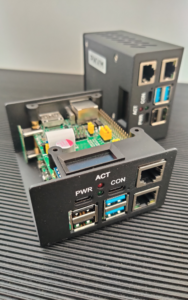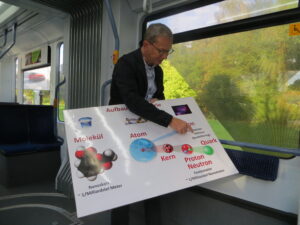24 August 2022
 To perform research at the frontier of knowledge, it is necessary to have excellent scientists and an extensive technical infrastructure with well-trained specialists. For this reason, the Institute for Nuclear Physics has, for many years, provided training for young people in technical and mechanical professions, such as IT specialists.
To perform research at the frontier of knowledge, it is necessary to have excellent scientists and an extensive technical infrastructure with well-trained specialists. For this reason, the Institute for Nuclear Physics has, for many years, provided training for young people in technical and mechanical professions, such as IT specialists.
This year, Jonas Bissantz and Jonas Steiner successfully completed their training as IT specialists, focusing on system integration at the Institute for Nuclear Physics. Mr. Bissantz’s project topic concerned the "Integration of an IP-KVM Solution for Remote Maintenance of Servers and Workstation Computers", an inexpensive "Keyboard-Video-Mouse" hardware based on RaspberryPis. In his project, Mr. Steiner dealt with the "Re-implementation of a Self-Hosted Warehouse Management System (WMS) on Existing Hardware".
We congratulate them both on the successful completion of their training and wish them all the best for their future careers!
 congratulate Dr. Robert Heine, who successfully completed his habilitation with his inaugural lecture on the topic
congratulate Dr. Robert Heine, who successfully completed his habilitation with his inaugural lecture on the topic
 The Gutenberg Academy of the Johannes Gutenberg University regularly supports up to 25 outstanding doctoral students and artists. In addition to interdisciplinary exchange and financial support for conference participation, for example, the junior members can benefit above all from the exchange with established scientists, as well as other renowned people from politics, business and society.
The Gutenberg Academy of the Johannes Gutenberg University regularly supports up to 25 outstanding doctoral students and artists. In addition to interdisciplinary exchange and financial support for conference participation, for example, the junior members can benefit above all from the exchange with established scientists, as well as other renowned people from politics, business and society. We congratulate Dr. Oleksandra Deineka on completing her PhD dissertation titled
We congratulate Dr. Oleksandra Deineka on completing her PhD dissertation titled

 February 11 is the International Day of Women and Girls in Science: A good occasion to introduce our new junior research group leader
February 11 is the International Day of Women and Girls in Science: A good occasion to introduce our new junior research group leader  We congratulate Ms. Bianca Savino on completing her dissertation titled
We congratulate Ms. Bianca Savino on completing her dissertation titled
 The Institute of Nuclear Physics is taking part in the Mainz Science Week! During a guided tour on 17.09.22 you will have the opportunity to experience the Mainz Microtron MAMI, an electron accelerator, on the JGU campus. We will show you the path the electrons take through the accelerator from their generation to the various experiments, explain the principle of a racetrack microtron and give you an insight into the experiments we use for our research.
The Institute of Nuclear Physics is taking part in the Mainz Science Week! During a guided tour on 17.09.22 you will have the opportunity to experience the Mainz Microtron MAMI, an electron accelerator, on the JGU campus. We will show you the path the electrons take through the accelerator from their generation to the various experiments, explain the principle of a racetrack microtron and give you an insight into the experiments we use for our research. To perform research at the frontier of knowledge, it is necessary to have excellent scientists and an extensive technical infrastructure with well-trained specialists. For this reason, the Institute for Nuclear Physics has, for many years, provided training for young people in technical and mechanical professions, such as IT specialists.
To perform research at the frontier of knowledge, it is necessary to have excellent scientists and an extensive technical infrastructure with well-trained specialists. For this reason, the Institute for Nuclear Physics has, for many years, provided training for young people in technical and mechanical professions, such as IT specialists.